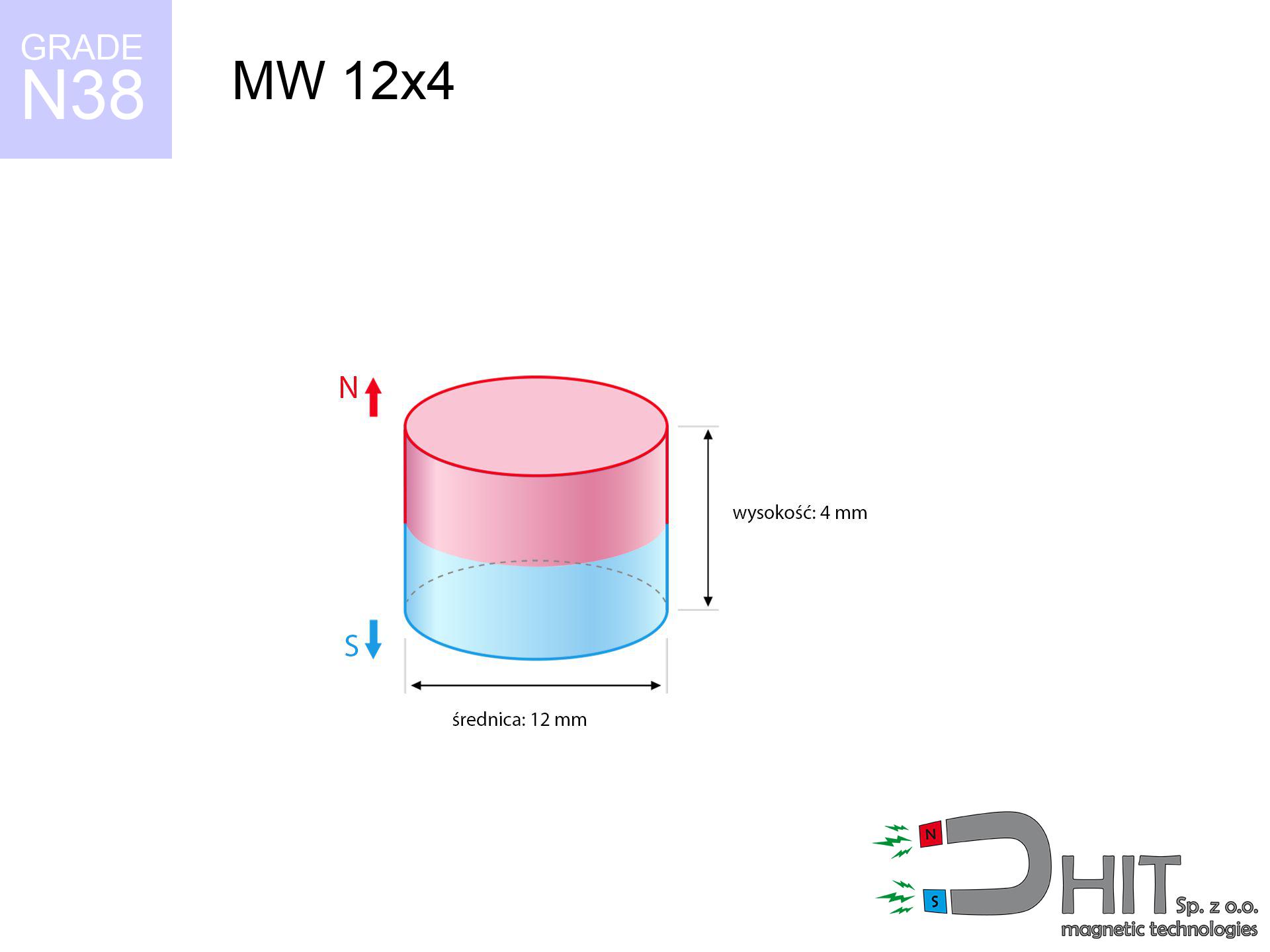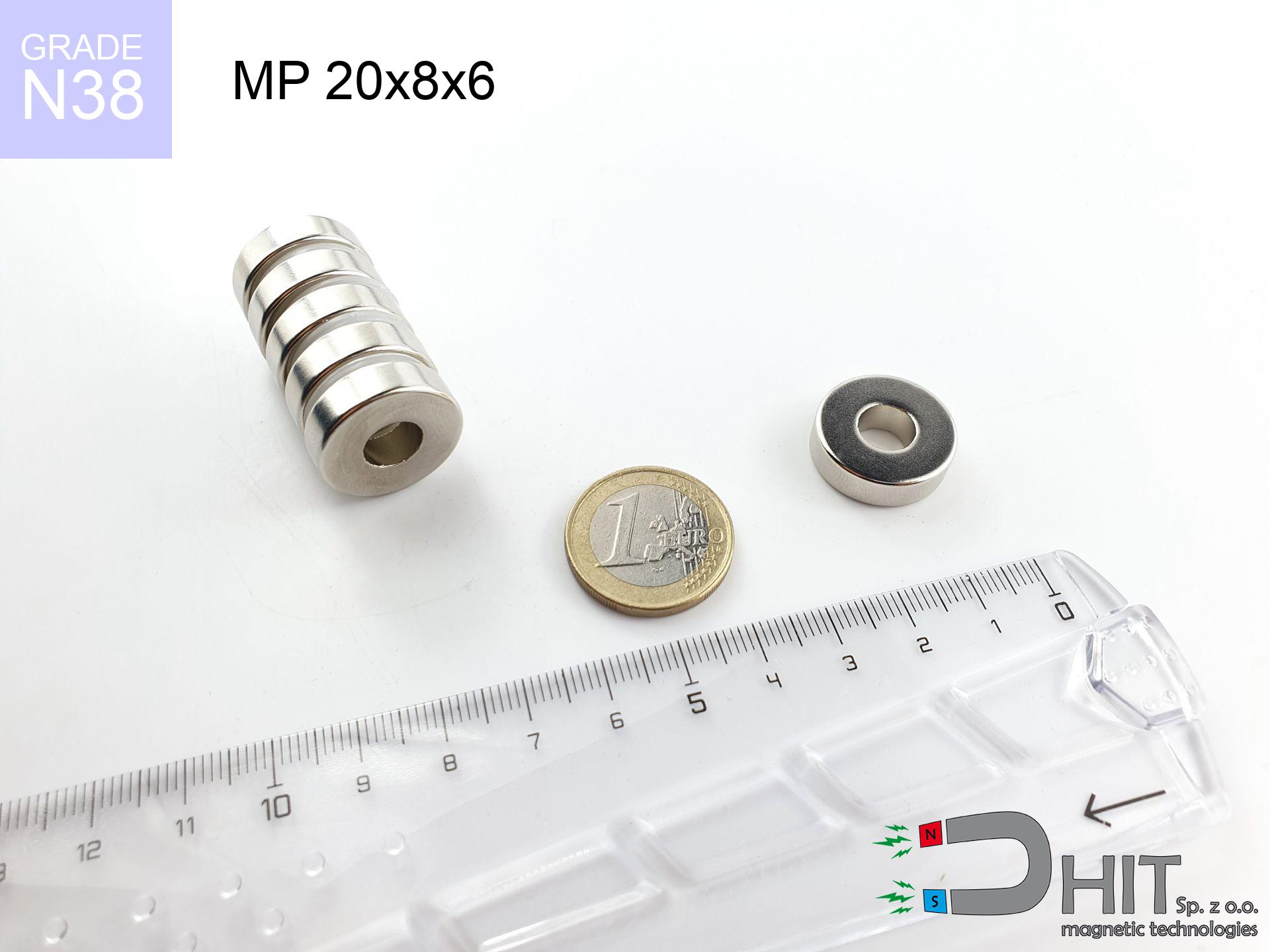MW 12x4 / N38 - neodymium magnet
cylindrical magnet
catalog number 010019
GTIN: 5906301810186
diameter Ø
12
mm [±0,1 mm]
height
4
mm [±0,1 mm]
magnetizing direction
↑ axial
capacity ~
2.65 kg / 25.99 N
magnetic induction ~
343.64 mT / 3,436 Gs
max. temperature
≤ 80
°C
catalog number 010019
GTIN: 5906301810186
diameter Ø
12 mm [±0,1 mm]
height
4 mm [±0,1 mm]
magnetizing direction
↑ axial
capacity ~
2.65 kg / 25.99 N
magnetic induction ~
343.64 mT / 3,436 Gs
max. temperature
≤ 80 °C
1.54 ZŁ gross price (including VAT) / pcs +
1.25 ZŁ net price + 23% VAT / pcs
bulk discounts:
need more quantity?Don't know what to choose?
Give us a call tel: +48 22 499 98 98 or get in touch through form on the contact page. You can check the strength and the shape of neodymium magnets in our magnetic calculator force calculator
Orders placed by 2:00 PM will be shipped on the same business day.
Specification: cylindrical magnet 12x4 / N38 ↑ axial
Magnetic properties of the material N38
Physical properties of sintered neodymium magnets Nd2Fe14B
Moreover, although neodymium is part of the strongest magnets, they are susceptible to corrosion in humid environments. For this reason, they are coated with a thin layer of gold-nickel to protect them from corrosion. It's worth noting that NdFeB neodymium magnets are about 13% lighter than SmCo magnets and, despite their power, easily break, which requires special caution during their handling. For this reason, any mechanical processing should be done before they are magnetized.
In terms of safety, there are many recommendations regarding the use of these magnets. They should not be used in acidic, basic, organic environments or in solvents, as well as in water or oil. Furthermore, they can damage data on magnetic cards and hard drives, although data deletion using a neodymium magnet is not always certain.
In terms of properties in different environments, neodymium magnets are sensitive to corrosion, especially in humid conditions. Therefore, they are often covered with coatings, such as gold, to preserve them from environmental factors and extend their lifespan. High temperatures exceeding 130°C can cause a loss of their magnetic properties, although there are specific types of neodymium magnets that can tolerate temperatures up to 230°C.
As for dangers, it is important to avoid using neodymium magnets in acidic conditions, basic environments, organic or solvent environments, unless they are properly protected. Additionally, their use is not recommended in water, oil, or in an environment containing hydrogen, as they may forfeit their magnetic properties.
List recommended items
Advantages as well as disadvantages of neodymium magnets NdFeB.
Apart from immense power, neodymium magnets have the following advantages:
- They do not lose power over time - after 10 years, their power decreases by only ~1% (theoretically),
- They are exceptionally resistant to demagnetization caused by an external magnetic field,
- In other words, thanks to the shiny nickel, gold, or silver finish, the element gains an visually attractive appearance,
- They exhibit very high magnetic induction on the surface of the magnet,
- Thanks to their high temperature resistance, they can operate (depending on the form) even at temperatures up to 230°C and above...
- The ability for precise shaping or customization to specific needs – neodymium magnets can be produced in many variants of shapes and sizes, which enhances their versatility in applications.
- Wide application in advanced technologically fields – are utilized in hard drives, electric drive mechanisms, medical devices or very highly developed apparatuses.
Disadvantages of neodymium magnets:
- They are prone to breaking as they are fragile when subjected to a powerful impact. If the magnets are exposed to impacts, we recommend using magnets in a steel housing. The steel housing in the form of a holder protects the magnet from impacts and also increases its overall strength,
- They lose power at high temperatures. Most neodymium magnets experience permanent loss of strength when heated above 80°C (depending on the form and height). However, we also offer special magnets with high temperature resistance, up to 230°C,
- Magnets exposed to a humid environment can corrode. Therefore, when using them outdoors, we suggest using waterproof magnets made of rubber, plastic, or other moisture-resistant materials,
- Limited ability to create threads or complex shapes in the magnet - the use of a housing is recommended - magnetic holder
- Potential hazard to health from tiny fragments of magnets are risky, if swallowed, which becomes significant in the aspect of protecting young children. It's also worth noting that small elements of these devices can be problematic in medical diagnosis in case of swallowing.
Exercise Caution with Neodymium Magnets
Avoid bringing neodymium magnets close to a phone or GPS.
Intense magnetic fields generated by neodymium magnets interfere with compasses and magnetometers used in navigation, as well as internal compasses of smartphones and GPS devices.
Magnets are not toys, children should not play with them.
Not all neodymium magnets are toys, so do not let children play with them. In such a situation, surgery is necessary to remove them. In the worst case scenario, it can result in death.
Dust and powder from neodymium magnets are flammable.
Avoid drilling or mechanical processing of neodymium magnets. Once crushed into fine powder or dust, this material becomes highly flammable.
Keep neodymium magnets away from TV, wallet, and computer HDD.
Strong magnetic fields emitted by neodymium magnets can damage magnetic storage media such as floppy disks, credit cards, magnetic ID cards, cassette tapes, video tapes, or other devices. They can also damage televisions, VCRs, computer monitors, and CRT displays. Avoid placing neodymium magnets in close proximity to electronic devices.
Neodymium magnets are primarily characterized by their significant internal force. They attract to each other, and any object that comes in their way will be affected.
If have a finger between or on the path of attracting magnets, there may be a large cut or a fracture.
Neodymium magnets are delicate and can easily break and shatter.
Neodymium magnets are highly delicate, and by joining them in an uncontrolled manner, they will crumble. Neodymium magnetic are made of metal and coated with a shiny nickel, but they are not as durable as steel. In the event of a collision between two magnets, there may be a scattering of fragments in different directions. Protecting your eyes is crucial in such a situation.
Avoid contact with neodymium magnets if you have a nickel allergy.
Studies clearly indicate a small percentage of people who suffer from metal allergies such as nickel. An allergic reaction often manifests as skin redness and rash. If you have a nickel allergy, you can try wearing gloves or simply avoid direct contact with nickel-plated neodymium magnets.
Neodymium magnets are the most powerful, most remarkable magnets on earth, and the surprising force between them can shock you at first.
Read the information on our website on how to properly utilize neodymium magnets and avoid significant harm to your body and unintentional damage to the magnets.
Neodymium magnets can become demagnetized at high temperatures.
Although magnets are generally resilient, their ability to maintain their magnetic potency can be influenced by factors like the type of material used, the magnet's shape, and the intended purpose for which it is employed.
Neodymium magnets should not be near people with pacemakers.
Neodymium magnets generate very strong magnetic fields that can interfere with the operation of a pacemaker. This happens because such devices have a function to deactivate them in a magnetic field.
To illustrate why neodymium magnets are so dangerous, see the article - How dangerous are powerful neodymium magnets?.








